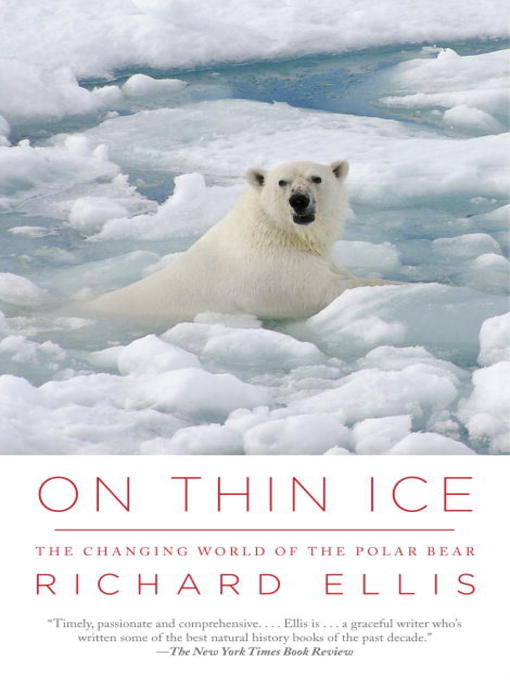
On Thin Ice
کتاب های مرتبط
- اطلاعات
- نقد و بررسی
- دیدگاه کاربران
نقد و بررسی

October 12, 2009
As climate change continues to shrink Arctic winter ice fields, the polar bear faces extinction possibly by the end of the century, a stark reality wrought vivid by prolific science writer Ellis (Tuna
) in this well-sourced geographical, historical, cultural, political and environmental overview. One of the largest land predators in the world, the great white bear—hunted almost to the brink of extinction decades ago, and after a population rebound reduced again to an estimated 22,000—has become the “poster child” for global warming. A dramatic reduction in permanent, year-round ice is inhibiting access to seals, its almost exclusive food source, and as natural prey becomes elusive, bears are resorting to cannibalism. Ellis, rendering complex science engagingly simple, peppers his authoritative assessment of ursine plight with interesting tidbits—bears and primates are the only bipedal mammals, for example. And despite an undeservedly fearsome reputation for savagery, the polar bear is in fact much less dangerous to man than man is to the bear, writes Ellis, as he pays impassioned homage to “a great white spirit.” Photos.

September 15, 2009
Veteran science writer Ellis (Tuna: A Love Story, 2008, etc.) celebrates the powerful white beast that has become the poster child for global warming.
Listed in 2008 as threatened under the Endangered Species Act, the polar bear has been transformed in recent years"from killer of seals and attacker of men to cute, furry, beloved icon," thanks to Coca-Cola advertising and consumers' preference for all things cuddly. In fact this awesome predator—now in decline and numbering 22,000 worldwide—long ruled the Arctic until men in ships spied their luxurious white pelts. Hunted by whalers and sportsmen, the bears became gifts for royalty and soon decorated floors in front of fireplaces. In this engrossing natural history, Ellis pays homage to the great bears and corrects misperceptions, noting that attacks by these beautiful giants are rare, and, given the sensitivity of their noses (they can smell a decaying whale carcass 20 miles away), they are easily thwarted with pepper spray. The author quotes at length from diaries, reports, articles and other material to describe these curious and individualistic mammals, which weigh up to 1,700 pounds and depend for their survival on the sea ice of several nations (Canada, United States, Denmark, Norway and Russia). Banned elsewhere, sport hunting is still permitted in parts of Canada, home to 15,000 of the world's polar bears; tourists pay up to $40,000 for guided hunting. Among other aspects of bear lore and history, Ellis describes the Inuits' fear and worship of the great bear; the lives of hunter-explorer Robert Peary and circus trainer Ursula Bottcher; and how polar bears fare in zoos, where, deprived of their customary surroundings, they sometimes act aberrantly and attack humans. The author includes a lengthy discussion of the"noticeable effect" of climate warming on the bears—from forcing them to swim further in search of ice floes, sometimes dying of exhaustion, to causing the collapse of the little dens that pregnant females dig in the snow, trapping the mother and cubs inside.
Timely and readable.
(COPYRIGHT (2009) KIRKUS REVIEWS/NIELSEN BUSINESS MEDIA, INC. ALL RIGHTS RESERVED.)

Starred review from October 15, 2009
Ellis, the dean of writers on the oceans and their denizens (The Encyclopedia of the Sea, 2000; Tuna, 2008), turns his thoughtful gaze to the polar bear, a magnificent carnivore that is both the largest land predator and a marine mammal. Although this dual nature makes the white bear fascinating, it is the marine part of its makeup that makes it an endangered species. In his usual mix of scholarly extraction from the writings of explorers, scientists, and journalists, and his own impassioned prose, Ellis presents the biology and natural history of the polar bear and its interactions with its seal prey and humans. Ellis discusses all of the countries that are home to polar bears, how they are viewed locally, and international treaties to protect the bear. The real strength of the book is its focus on the polar bear as the poster child of global warming, of how tied the bears are to the arctic ice and what will happen if the ice melts, and of the national and international wrangling over the politics of climate change and the listing of the bear as an endangered species. The polar bear could not ask for a better champion than Ellis in this highly recommended work.(Reprinted with permission of Booklist, copyright 2009, American Library Association.)

























دیدگاه کاربران